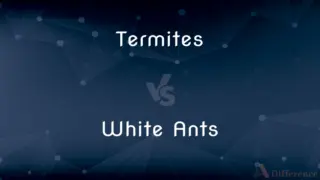Chlorophyll A vs. Chlorophyll B — What's the Difference?
By Tayyaba Rehman — Published on November 21, 2023
Chlorophyll A absorbs violet-blue and red light, crucial for energy conversion in photosynthesis, while Chlorophyll B, assisting in capturing light energy, absorbs blue and orange light and transfers energy to Chlorophyll A.

Difference Between Chlorophyll A and Chlorophyll B
Table of Contents
ADVERTISEMENT
Key Differences
Chlorophyll A significantly functions as the primary pigment in photosynthesis, embedding itself as an indispensable component in the process. It predominantly absorbs violet-blue and red light, ensuring that the light energy is seamlessly converted into chemical energy. Chlorophyll A, with its distinct absorption spectrum, plays a pivotal role in driving the light reactions of photosynthesis, acting as the primary electron donor in the electron transport chain.
Chlorophyll B stands out as an accessory pigment, diligently absorbing light energy and transferring it to Chlorophyll A, effectively expanding the spectrum of light that can be utilized by the plant for energy. It prominently absorbs light in the blue and orange spectrum, wavelengths that are not as effectively absorbed by Chlorophyll A. Chlorophyll B, therefore, aids in optimizing the energy absorption capacity of plants, ensuring no potential light energy is wasted.
Distinct in their chemical structures, Chlorophyll A contains a methyl group (-CH3) in its structure, whereas Chlorophyll B incorporates an aldehyde group (-CHO). This fundamental difference in their molecular structures influences their respective absorption spectra. Consequently, Chlorophyll A and Chlorophyll B function in synergy, ensuring that the plant can utilize a broader range of light for its photosynthetic processes.
Moreover, while Chlorophyll A is present in all oxygenic photosynthesizing organisms, such as green algae and plants, Chlorophyll B is found predominantly in land plants and green algae. The strategic presence of Chlorophyll B in these organisms is suggestive of its pivotal role in adapting to fluctuating light conditions, providing a versatile and adaptive approach towards maximizing light energy utilization amidst variable environmental scenarios.
Holistically, Chlorophyll A and Chlorophyll B collaborate to ensure the efficacy and optimization of light energy absorption and conversion in the intricate process of photosynthesis. Their complementary roles and slightly varied absorption spectra facilitate the exhaustive absorption and utilization of light, ultimately driving the life-giving process of photosynthesis that underpins the existence of life on Earth.
ADVERTISEMENT
Comparison Chart
Primary Function
Primary pigment in photosynthesis
Accessory pigment, transfers energy to Chlorophyll A
Absorption Spectrum
Absorbs violet-blue and red light
Absorbs blue and orange light
Chemical Group
Contains a methyl group (-CH3)
Contains an aldehyde group (-CHO)
Presence
In all oxygenic photosynthesizing organisms
Mainly in land plants and green algae
Role in Photosynthesis
Main electron donor
Energy transfer to Chlorophyll A
Compare with Definitions
Chlorophyll A
Contains a methyl group.
The chemical structure of Chlorophyll A includes -CH3.
Chlorophyll B
An accessory photosynthetic pigment.
Chlorophyll B assists Chlorophyll A by transferring energy.
Chlorophyll A
Primary photosynthetic pigment.
Chlorophyll A plays a central role in photosynthesis.
Chlorophyll B
Contains an aldehyde group.
The -CHO group differentiates Chlorophyll B structurally.
Chlorophyll A
Main electron donor in photosynthesis.
Chlorophyll A initiates the electron transport chain.
Chlorophyll B
Present in land plants and green algae.
Chlorophyll B is abundant in various land-dwelling flora.
Chlorophyll A
Absorbs violet-blue and red light.
Chlorophyll A's absorption maximizes energy conversion.
Chlorophyll B
Aids in adapting to variable light conditions.
Chlorophyll B ensures optimal light energy absorption.
Chlorophyll A
Essential for all oxygenic photosynthesizing organisms.
All green plants contain Chlorophyll A.
Chlorophyll B
Absorbs blue and orange light.
Chlorophyll B expands the light absorption spectrum for plants.
Common Curiosities
Why is Chlorophyll A green?
It reflects green light, absorbing other wavelengths.
Is Chlorophyll B essential for photosynthesis?
It enhances the efficiency of photosynthesis by broadening light absorption.
Can plants survive with only Chlorophyll B?
No, as Chlorophyll B doesn't initiate electron transport in photosynthesis.
Are Chlorophyll A and B found in all plants?
Yes, generally both are found in green plants.
What makes Chlorophyll A and B chemically different?
Chlorophyll A has a methyl group; B has an aldehyde group.
Why is Chlorophyll B important in varied light conditions?
It ensures maximum light absorption by capturing additional wavelengths.
Can Chlorophyll A function without Chlorophyll B?
It can function, but with limited light absorption efficiency.
What role does Chlorophyll B play in shade plants?
It aids in absorbing the available light more efficiently.
Which Chlorophyll is more widespread?
Chlorophyll A is more widespread and fundamental.
Why is Chlorophyll A considered primary?
It directly initiates electron transport in photosynthesis.
Which Chlorophyll is crucial for energy conversion?
Chlorophyll A.
Can Chlorophyll B absorb the same light as Chlorophyll A?
Partially, but Chlorophyll B mainly absorbs blue and orange light.
Do all photosynthesizing organisms have Chlorophyll B?
No, it's mainly in land plants and green algae.
Are Chlorophyll A and B the only types of chlorophyll?
No, there are others like Chlorophyll C, D, and bacteriochlorophyll.
Can Chlorophyll B start the electron transport chain?
No, it cannot.
Share Your Discovery

Previous Comparison
Termites vs. White Ants
Next Comparison
Dew Point vs. HumidityAuthor Spotlight
Written by
Tayyaba RehmanTayyaba Rehman is a distinguished writer, currently serving as a primary contributor to askdifference.com. As a researcher in semantics and etymology, Tayyaba's passion for the complexity of languages and their distinctions has found a perfect home on the platform. Tayyaba delves into the intricacies of language, distinguishing between commonly confused words and phrases, thereby providing clarity for readers worldwide.













































